Experimental Investigation of Micropile Stiffness Affecting the Underpinning of an Existing Foundation
Abstract
:1. Introduction
2. Model Tests
2.1. Model Tests Considering Construction Procedure
2.2. Test Apparatus
2.3. Test Series and Experimental Setups
3. Results and Discussion
3.1. Single Pile Loading Test
3.2. Underpinned Foundation Behavior
3.2.1. Load Settlement Behavior of Underpinned Foundations
3.2.2. Axial Load Transfer Mechanism in Micropiles
3.2.3. Comparison of Underpinning Piles’ Load Sharing Behavior
4. Conclusions
Author Contributions
Funding
Conflicts of Interest
References
- Butcher, A.P.; Powell, J.J.M.; Skinner, H.D. Reuse of Foundations for Urban Sites—Foundation Reuse Best Practice Handbook; BRE Press: Watford, UK, 2006. [Google Scholar]
- Chapman, T.; Anderson, S.; Windle, J. Reuse of Foundations CIRIA 653; CIRIA: London, UK, 2007; ISBN 978-086017-653-4. [Google Scholar]
- Laefer, D.F. Quantitative support for a qualitative foundation reuse assessment tool. In Proceedings of the Geo-Frontiers 2011: Advances in Geotechnical Engineering, Dallas, TX, USA, 13–16 March 2011; pp. 113–121. [Google Scholar]
- MOLIT. Housing Act; Korea Ministry of Land, Infrastructure and Transport: Sejong, Korea, 2013. (In Korean)
- Thorburn, S.; Hutchison, J. Underpinning; Surrey University Press: Glasgow, UK, 1985. [Google Scholar]
- Bruce, D.A. In-situ Earth Reinforcing by Soil Nailing. In Underpinning and Retention; Springer: New York, NY, USA, 1993; pp. 340–394. [Google Scholar]
- Cole, K.W. Conventional Piles in Underpinning. In Underpinning and Retention; Springer: New York, NY, USA, 1993; pp. 63–83. [Google Scholar]
- Lizzi, F. “Pali Radice” Structures. In Underpinning and Retention; Springer: New York, NY, USA, 1993; pp. 84–156. [Google Scholar]
- Van der Stoel, A.E.C. Grouting for Pile Foundation Improvement; Delft University Press: Delft, The Netherlands, 2001. [Google Scholar]
- Lizzi, F. The Static Restoration of Monuments: Basic Criteria, Case Histories: Strengthening of Buildings Damaged by Earthquakes; Sagep: Genova, Italy, 1982; p. 146. [Google Scholar]
- Han, J. Principles and Practice of Ground Improvement; John Wiley & Sons: New York, NY, USA, 2015. [Google Scholar]
- Bruce, D.A. Aspects of minipiling practice in the United States. J. Ground Eng. 1989, 22, 35–39. [Google Scholar]
- Bruce, D.A.; Diaillio, A.F.; Juran, I. Micropiles: The state of practice. Ground Improv. 1997, 1, 25–35. [Google Scholar] [CrossRef]
- FHWA. Micropile Design and Construction Guidelines; US Department of Transportation: Washington, DC, USA, 2005.
- Han, J.; Ye, S.L. A Field Study on the Behavior of micropiles in clay under compression or tension. Can. Geotech. J. 2006, 43, 19–29. [Google Scholar] [CrossRef]
- Esmaeili, M.; Nik, M.G.; Khayyer, F. Experimental and Numerical Study of Micropiles to Reinforce High Railway Embankments. Int. J. Geomech. 2013, 13, 729–744. [Google Scholar] [CrossRef]
- Tsukada, Y.; Miura, K.; Tsubokawa, Y.; Otani, Y.; You, G.L. Mechanism of Bearing Capacity of Spread Footings Reinforced with Micropiles. Soils Found. 2006, 46, 367–376. [Google Scholar] [CrossRef] [Green Version]
- KHS. Korea Highway Bridge Design Standard, Explanation; KHS: Dortmund, Germany, 2008; pp. 885–887. [Google Scholar]
- JGJ. Technical Code for Improvement of Soil and Foundation of Existing Buildings; JGJ: Beijing, China, 2012. (In Chinese) [Google Scholar]
- Makarchian, M.; Poulos, H.G. Simplified Method for Design of Underpinning Piles. J. Geotech. Eng. 1996, 122, 745–751. [Google Scholar] [CrossRef]
- Han, J.; Ye, S.L. A Field Study on the Behavior of a Foundation Underpinned by Micropile. Can. Geotech. J. 2006, 43, 30–42. [Google Scholar] [CrossRef]
- El Kamash, W.; Han, J. Numerical analysis of existing foundations underpinned by micropile. Int. J. Geomech. 2016, 17. [Google Scholar] [CrossRef]
- Jang, Y.E.; Han, J.T. Development on the Micropile for Applying to Artificial Ground above Railroad Site. Adv. Sci. Technol. Lett. 2014, 55, 43–46. [Google Scholar]
- Turner, J.P.; Kulhawy, F.H. Physical Modeling of Drilled Shaft Side Resistance in Sand. Geotech. Test. J. 1994, 17, 282–290. [Google Scholar]
- Poulos, H.G.; Chen, L.T.; Hull, T.S. Model Tests on Single Piles Subjected to Lateral Soil Movement. Soils Found. 1995, 35, 85–92. [Google Scholar] [CrossRef] [Green Version]
- Pan, J.L.; Goh, A.T.; Wong, K.S.; Teh, C.I. Model tests on single piles in soft clay. Can. Geotech. J. 2000, 37, 890–897. [Google Scholar] [CrossRef]
- Lee, S.; Chung, C.K. An Experimental Study of the Interaction of Vertical Loaded Pile groups in Sand. Can. Geotech. J. 2005, 42, 1485–1493. [Google Scholar] [CrossRef]
- Al-Mahdi, A.I. Experimental investigation of the behavior of pile groups in sand under different loading rates. Geotech. Geol. Eng. 2006, 24, 889–902. [Google Scholar]
- Baziar, M.H.; Ghorbani, A.; Katzenbach, R. Small-Scale Model Test and Three-Dimensional Analysis of Pile-Raft Foundation on Medium-Dense Sand. Int. J. Civ. Eng. 2009, 7, 170–175. [Google Scholar]
- El Sawwaf, M. Experimental Study of Eccentrically Loaded Raft with Connected and Unconnected Short Piles. J. Geotech. Geoenviron. Eng. 2010, 136, 1394–1402. [Google Scholar] [CrossRef]
- El Garhy, B.; Galil, A.A.; Youssef, A.F.; Raia, M.A. Behavior of raft on settlement reducing piles: Experimental model study. J. Rock Mech. Geotech. Eng. 2013, 5, 389–399. [Google Scholar] [CrossRef] [Green Version]
- Elwakil, A.Z.; Azzam, W.R. Experimental and numerical study of piled raft system. Alex. Eng. J. 2016, 55, 547–560. [Google Scholar] [CrossRef] [Green Version]
- Rollins, K.M.; Olsen, K.G.; Jensen, D.H.; Garrett, B.H.; Olsen, R.J.; Egbert, J.J. Pile Spacing Effects on Lateral Pile Group Behavior: Analysis. J. Geotech. Geoenviron. Eng. 2006, 132, 1272–1283. [Google Scholar] [CrossRef]
- Das, B.M. Principles of Foundation Engineering; Cengage Learning: Andover, UK, 2015. [Google Scholar]
- Jang, Y.E.; Han, J.T. Study of Load Capacity of Waveform Micropile by Centrifuge test. In Proceedings of the 25th International Offshore and Polar Engineering Conference, Kona, HI, USA, 21–26 June 2015. [Google Scholar]
- Jang, Y.E.; Han, J.T. Field Study on Axial Bearing Capacity and Load Transfer Characteristic of Waveform Micropile. Can. Geotech. J. 2018, 55, 653–665. [Google Scholar] [CrossRef]
- Jang, Y.E.; Han, J.T. Analysis of the Shape Effect on the Axial Performance of a Waveform Micropile by Centrifuge Model Tests. Acta Geotech. 2019, 14, 505–518. [Google Scholar] [CrossRef]
- Wood, D.M. Geotechnical Modelling; CRC Press: London, UK, 2014. [Google Scholar]
- Iai, S. Similitude for Shaking Table Test on Soil-structure-fluid Model in 1g Gravitational Field. Soils Found. 1998, 29, 105–118. [Google Scholar] [CrossRef]
- Park, L.K.; Suneel, M.; Chul, I.J. Shear Strength of Jumunjin Sand According to Relative Density. Mar. Georesour. Geotechnol. 2008, 26, 101–110. [Google Scholar] [CrossRef]
- EN, B.S. Eurocode 7: Geotechnical Design—Part 1: General Rules; British Standards: London, UK, 2004. [Google Scholar]
- Ahmed, A.; El Naggar, M.H.; El Naggar, H. Performance of micropiled raft in clay subjected to vertical concentrated load: Centrifuge modeling. Can. Geotech. J. 2015, 52, 2017–2029. [Google Scholar]
- Jang, Y.E.; Kim, B.M.; Wang, C.C.; Han, J.T. Prediction of vertical bearing capacity of waveform micropile. Geotech. Lett. 2019. accepted. [Google Scholar]
- Randolph, M.R.; Wroth, C.P. An Analysis of the Vertical Deformation of Pile Groups. Geotechnique 1979, 29, 423–439. [Google Scholar] [CrossRef]
- Ji, J.; Zhang, C.S.; Gao, Y.F.; Kodikara, J. Effect of 2D Spatial Variability on Slope Reliability: A Simplified FORM Analysis. Geosci. Front. 2018, 9, 1631–1638. [Google Scholar] [CrossRef]
- Ji, J.; Zhang, C.S.; Gao, Y.F.; Kodikara, J. Reliability-based design for geotechnical engineering: An inverse FORM approach for practice. Comput. Geotech. 2019, 111, 22–29. [Google Scholar] [CrossRef]

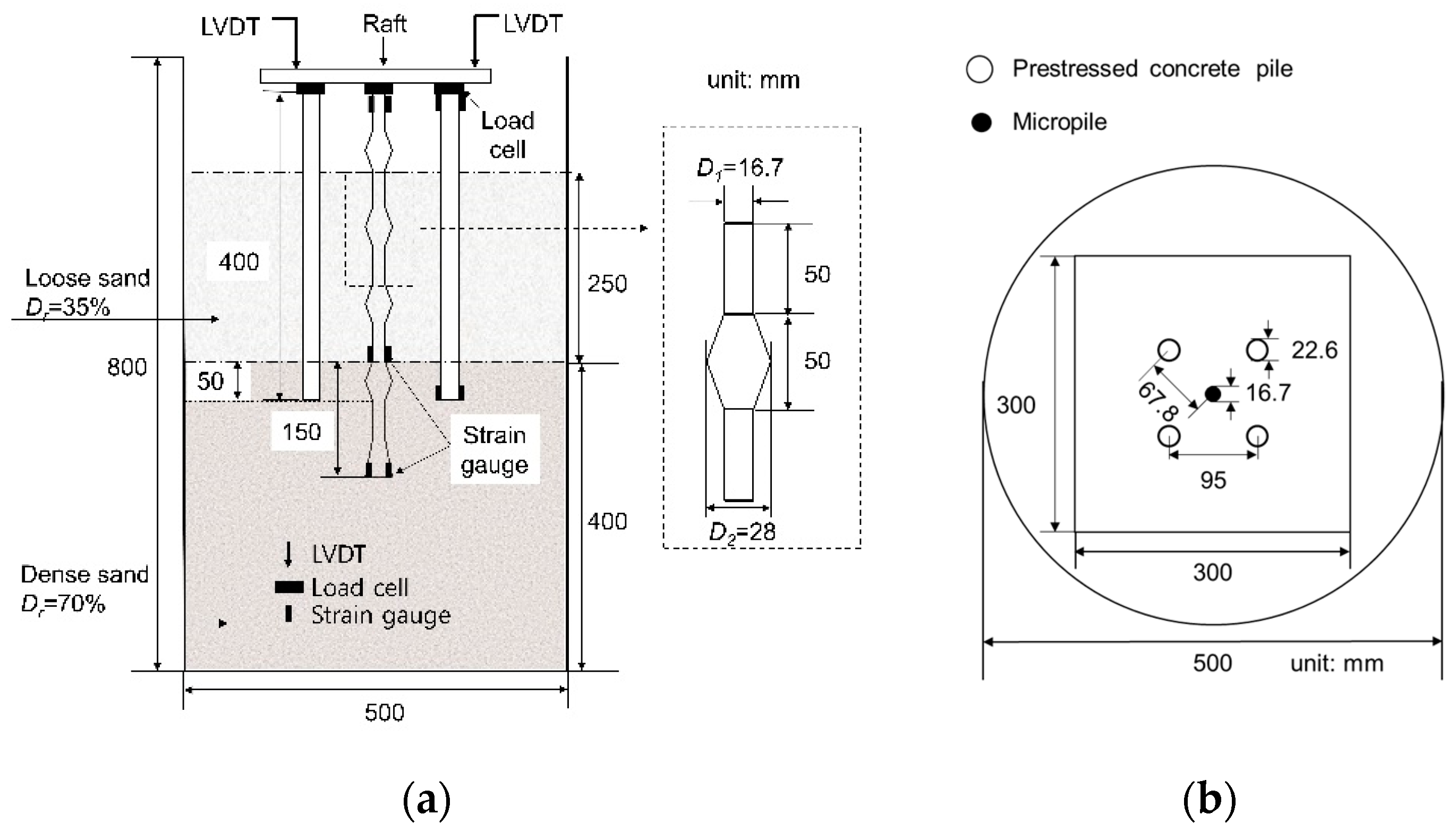
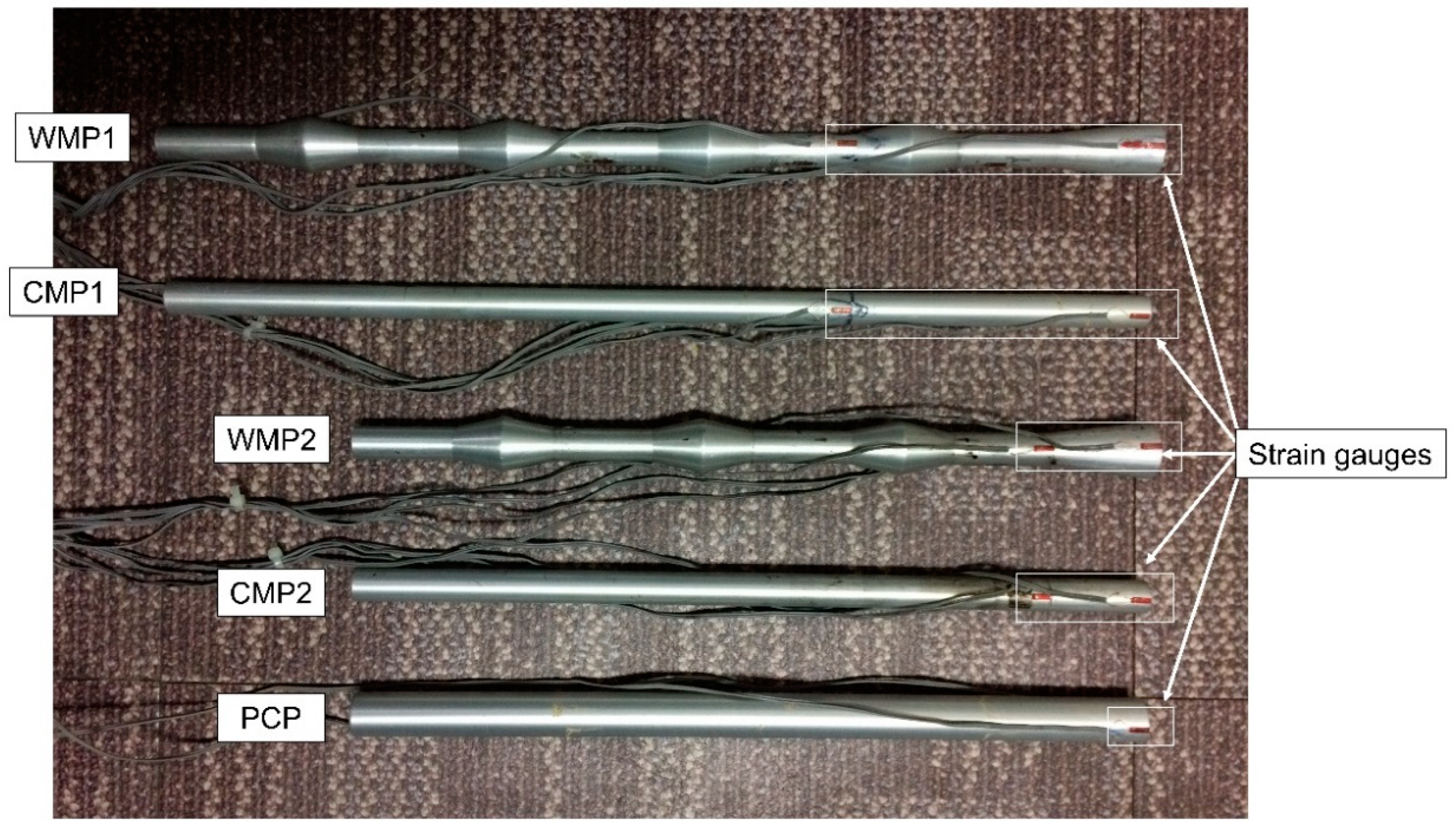



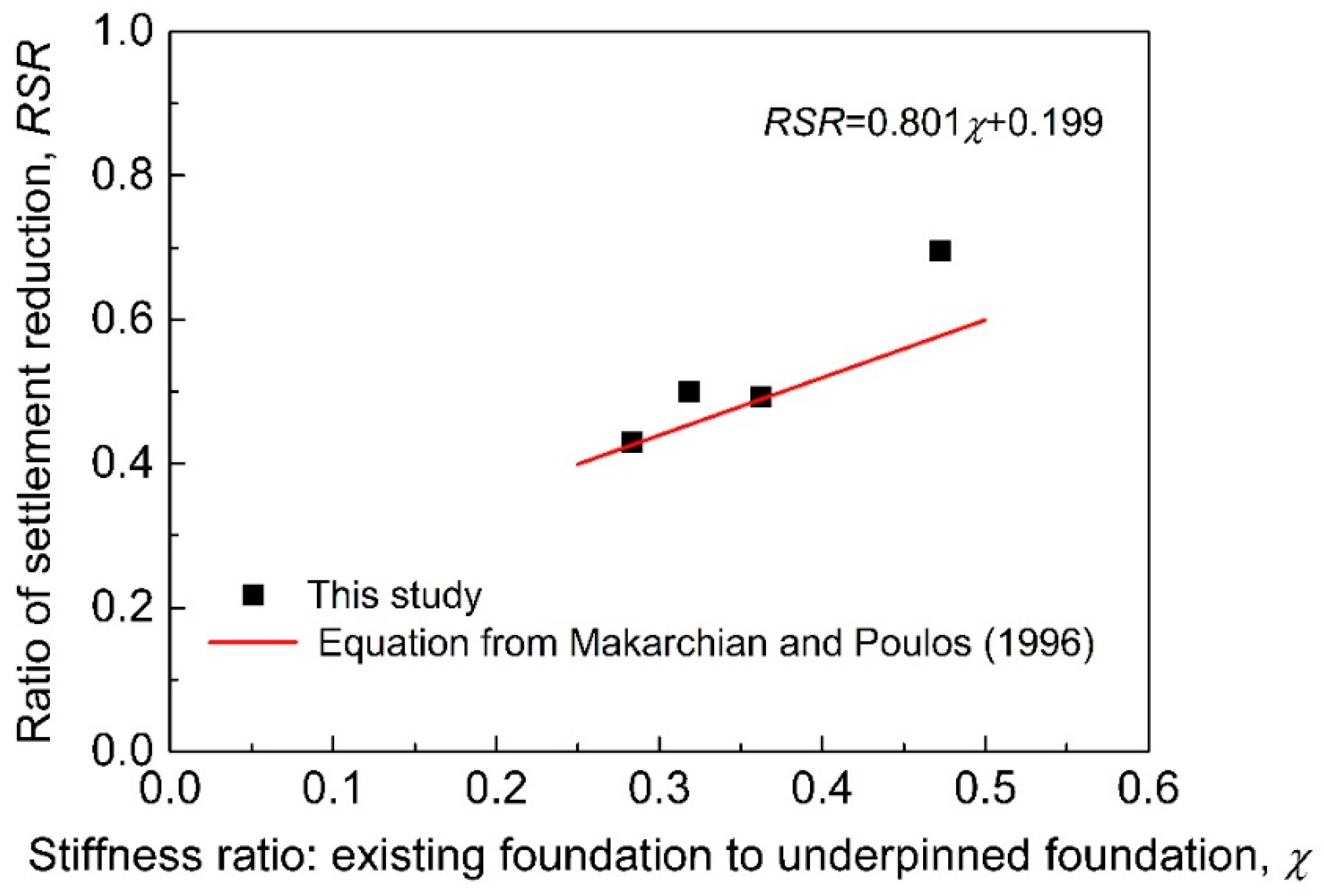
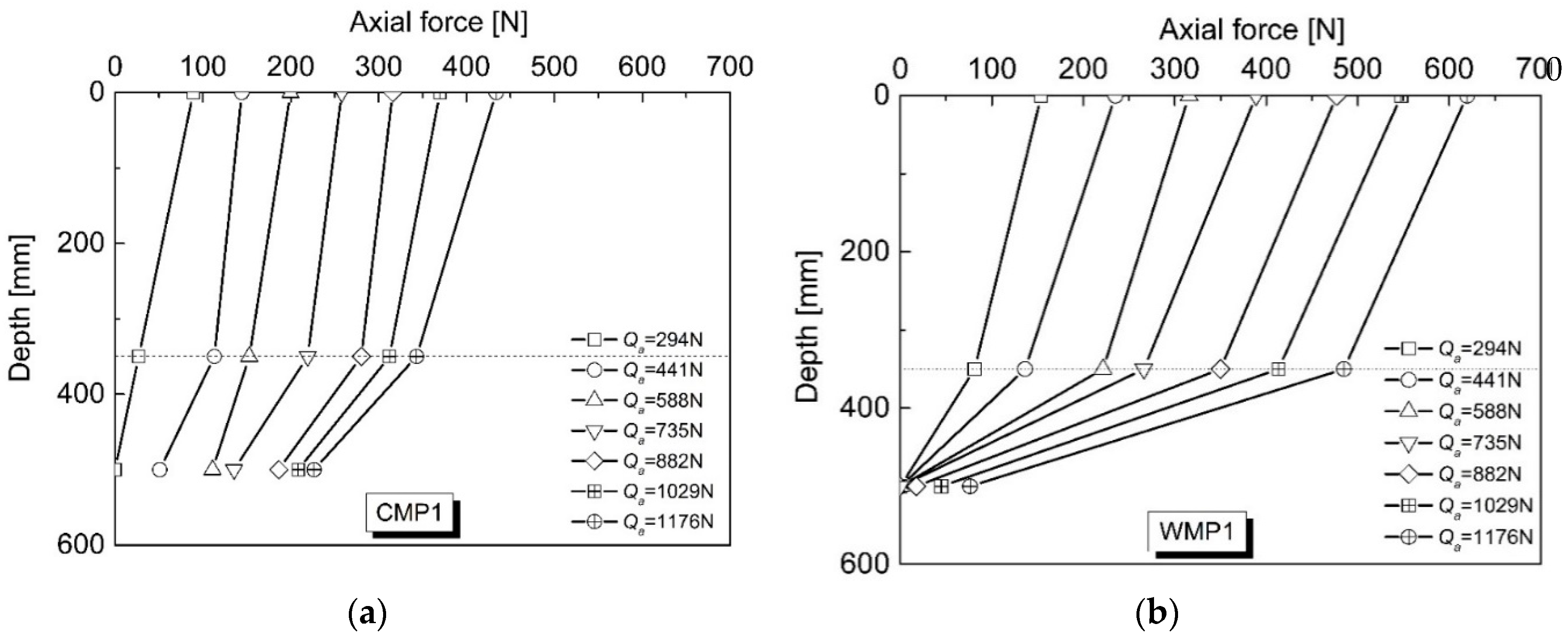

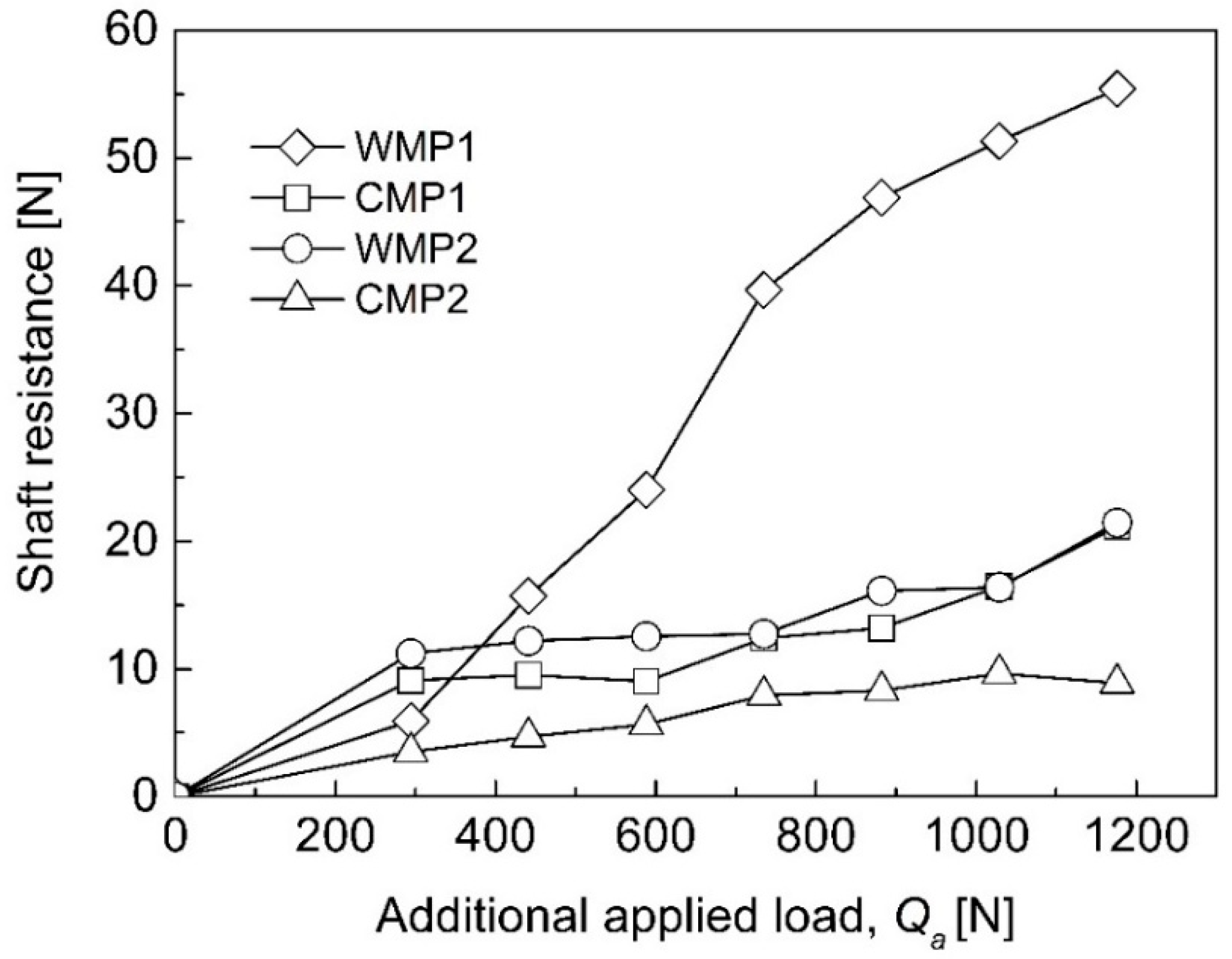

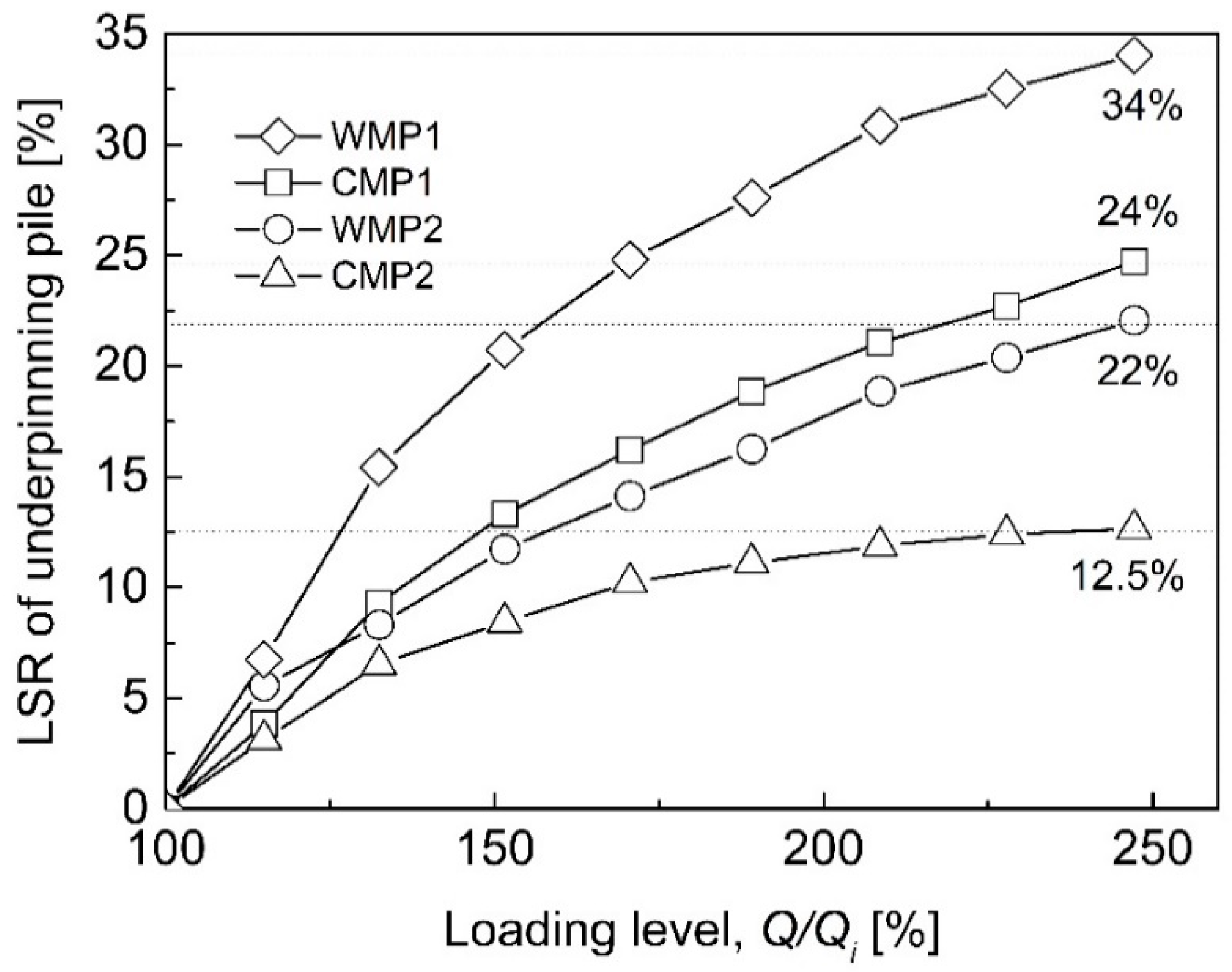
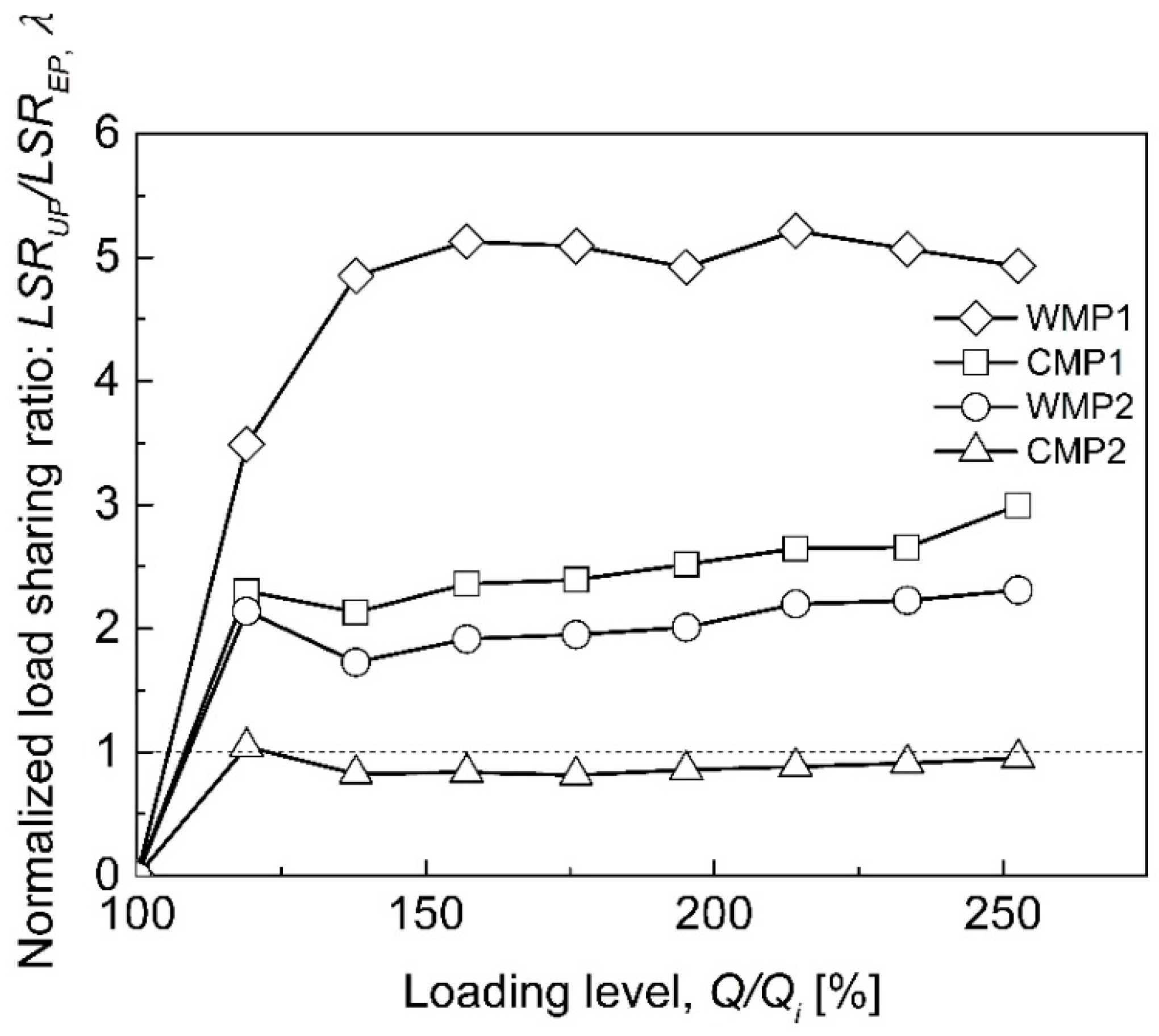
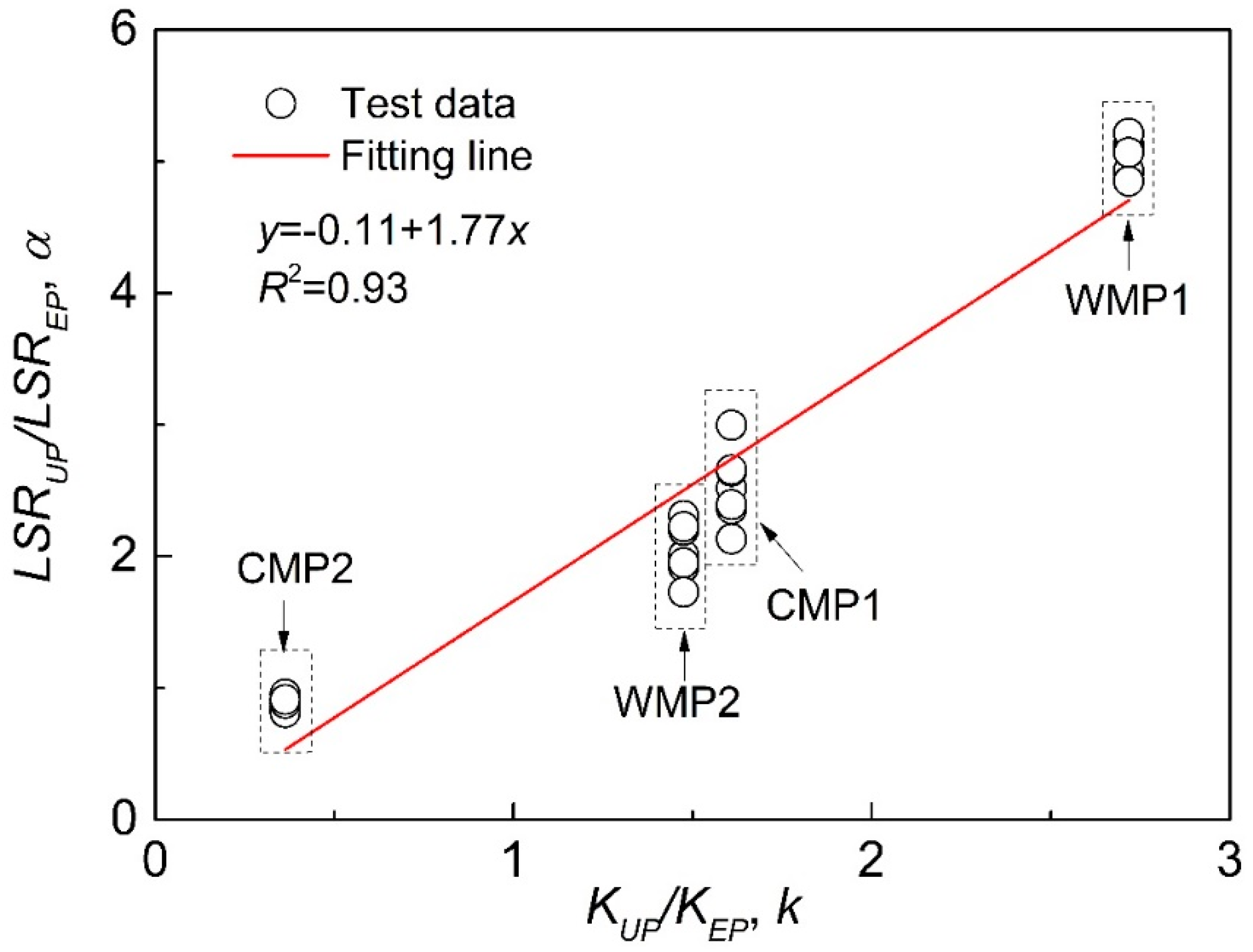
| Pile | Type | Prototype Pile | Model Pile | ||||
|---|---|---|---|---|---|---|---|
| Diameter (mm) | Length (mm) | Young’s Modulus (GPa) | D (mm) | L (mm) | Young’s Modulus (GPa) | ||
| Existing pile (EP) | PCP | 350 | 8000 | 35 (Concrete) | 22.6 | 400 | 69 (Aluminum) |
| Underpinning pile (UP) | WMP1 1 | D1: 200 D2: 333 | 10,000 | 42.8 (Concrete + steel) | D1: 16.7 D2: 28 | 500 | |
| WMP2 2 | 8000 | 400 | |||||
| CMP1 3 | 200 | 10,000 | 16.7 | 500 | |||
| CMP2 4 | 8000 | 400 | |||||
| Type | Underpinning Pile (UP) | Existing Pile (EP) | |||
|---|---|---|---|---|---|
| WMP1 | CMP1 | WMP2 | CMP2 | PCP | |
| Qult (N) | > 1000 | 998 | 612 | 141 | 460 |
| Qall (N) | > 333 | 332 | 204 | 47 | 153 |
| Kslope (N/mm) | 1500 | 888 | 814 | 200 | 552 |
| Keq (N/mm) | 1277 | 766 | 798 | 478 | 647 |
| K (KUP/KEP) | 2.70 | 1.60 | 1.47 | 0.36 | |
© 2019 by the authors. Licensee MDPI, Basel, Switzerland. This article is an open access article distributed under the terms and conditions of the Creative Commons Attribution (CC BY) license (http://creativecommons.org/licenses/by/4.0/).
Share and Cite
Wang, C.; Han, J.-T.; Jang, Y.-E. Experimental Investigation of Micropile Stiffness Affecting the Underpinning of an Existing Foundation. Appl. Sci. 2019, 9, 2495. https://doi.org/10.3390/app9122495
Wang C, Han J-T, Jang Y-E. Experimental Investigation of Micropile Stiffness Affecting the Underpinning of an Existing Foundation. Applied Sciences. 2019; 9(12):2495. https://doi.org/10.3390/app9122495
Chicago/Turabian StyleWang, Chengcan, Jin-Tae Han, and Young-Eun Jang. 2019. "Experimental Investigation of Micropile Stiffness Affecting the Underpinning of an Existing Foundation" Applied Sciences 9, no. 12: 2495. https://doi.org/10.3390/app9122495





